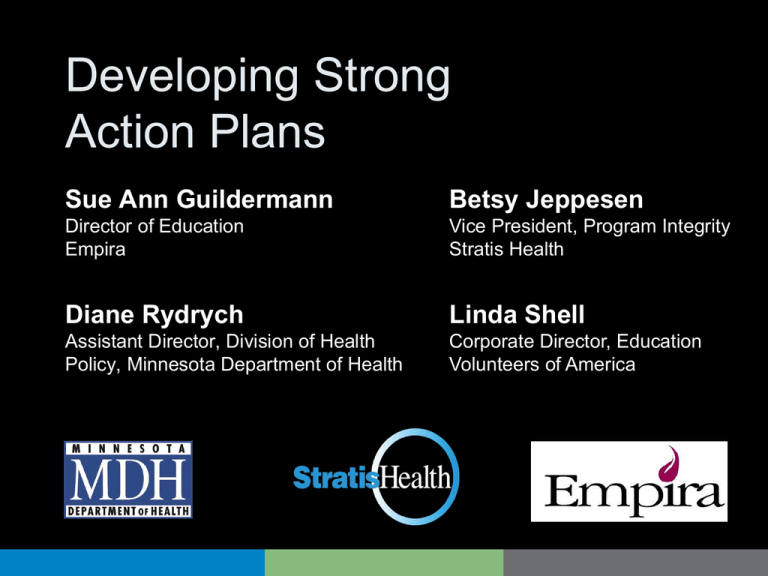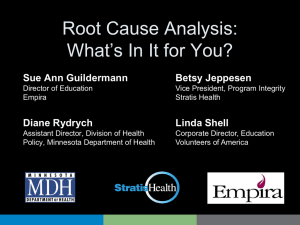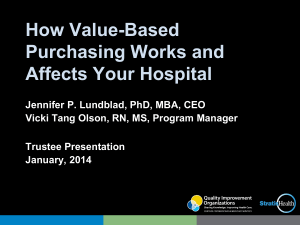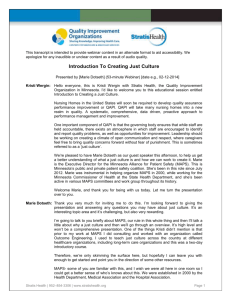Developing Strong Action Plans - Minnesota Department of Health
advertisement

Developing Strong Action Plans Sue Ann Guildermann Betsy Jeppesen Director of Education Empira Vice President, Program Integrity Stratis Health Diane Rydrych Linda Shell Assistant Director, Division of Health Policy, Minnesota Department of Health Corporate Director, Education Volunteers of America Now that you know the root causes and contributing factors that led to the event or serious accident, what actions will you put into place to reduce the chance of it reoccurring? Corrective actions often include: • Education and training • Telling staff to “be more careful” • If we stop at these actions, will we prevent a reoccurrence? Hierarchy of actions • National Center for Patient Safety’s “Hierarchy of Actions” classifies corrective actions as: – Weaker: actions that depend on staff to remember their training or remember what is written in the policy – Intermediate: actions are somewhat dependent on staff remembering to do the right thing, but they provide tools to help staff to remember or to promote clear communication – Strong: actions that do not depend on staff to remember to do the right thing; the action may not totally eliminate the vulnerability but provide very strong controls Dept of Veterans Affairs National Center for Patient Safety, http://www.patientsafety.gov/CogAids/RCA/index.html To be most effective, action plans need to move to stronger actions than education or reminders alone Hierarchy of actions: weaker • • • • • Double checks (risk for human error) Posters or signs on the new requirement New procedure, policy, memo Training alone Additional study/analysis Dept of Veterans Affairs National Center for Patient Safety, http://www.patientsafety.gov/CogAids/RCA/index.html Hierarchy of actions: intermediate • • • • • • • • Redundancy—everyone entering room looks for “x” Eliminate/reduce distractions Checklists, cognitive aids Eliminate look-alikes and sound-a-likes Read back—verbal orders Software enhancements/modifications Increase staffing; decrease workload Enhanced documentation/communication Dept of Veterans Affairs National Center for Patient Safety, http://www.patientsafety.gov/CogAids/RCA/index.html Hierarchy of actions: stronger • Physical plant changes—e.g., moving a grab bar • Simplify the process—remove unnecessary steps or steps that no longer make sense • Standardize equipment or process to reduce variation • Conduct usability testing before purchasing new devices—will it really do what you need? Hierarchy of actions: stronger • Engineering controls (forcing functions): – Edits on electronic medical record that won’t let you exit until a field is filled – IV tubing that will not allow you to connect certain types of piggy backs • Tangible involvement/action by leadership in support of resident and staff safety – Leadership checks in with staff during rounds on how a new process is going, and follows up if issues are identified Action plans Are action plans: • Linked directly to the root cause(s) and contributing factors—will the actions keep event from happening again? • Easily understood and can be implemented —practical and achievable? • Developed whenever possible with involvement of those closest to the process? Action plans Does the action plan: • Identify someone who will be responsible for implementation (not necessarily the one who will do all the steps, but who will check in with the team to assure it is accomplished)? • Have an identified target date for implementation? • Include a measurement plan to determine if the change is having the intended effect? Action plans • Important to communicate plan to leadership and staff—sharing at staff meetings is not enough (a weak action) • Regular interaction with staff carrying out plan is key to evaluating if it is working and to make sure the fix sticks Follow through • Appreciate and recognize staff efforts • Listen to staff when they share impact of the change • Share data that shows impact with staff (residents and families if appropriate) • Be ready to consider additional analysis or action if the plan is not having the intended effect Questions? Sue Ann Guildermann Director of Education Empira 952-259-4477 sguilder@empira.org www.empira.org Betsy Jeppesen Vice President, Program Integrity Stratis Health 952-853-8510 or 877-787-2847 bjeppesen@stratishealth.org www.stratishealth.org Diane Rydrych Assistant Director Division of Health Policy Minnesota Department of Health 651-201-3564 Diane.rydrych@state.mn.us www.health.state.mn.us/patientsafety Linda Shell Corporate Director, Education and Learning Volunteers of America 651-503-8885 lshell@voa.org Protecting, maintaining, and improving the health of all Minnesotans. Stratis Health is a nonprofit organization that leads collaboration and innovation in health care quality and safety, and serves as a trusted expert in facilitating improvement for people and communities.











